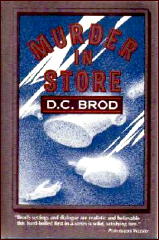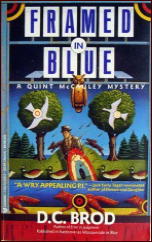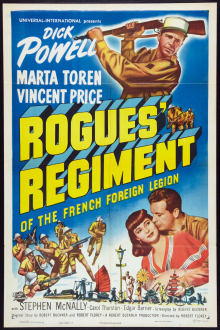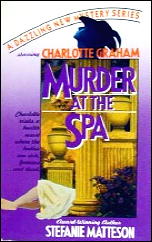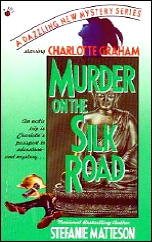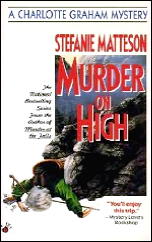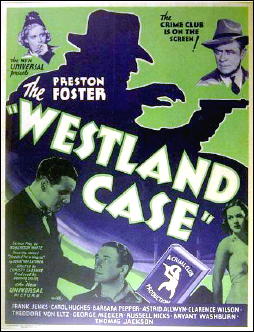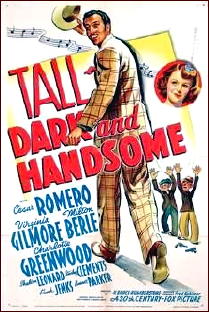September 2011
Monthly Archive
Sun 25 Sep 2011
D. C. BROD – Error in Judgment. Diamond, paperback reprint, September 1991. Hardcover edition: Walker, July 1990.
As you’ve probably noticed, paperbacks are making quantum jumps in terms of prices. I’m not sure where the upper limit is, in terms of public resistance to bigger and bigger chunks of available spending money, but so far nothing seems to be keeping the cost of reading material from jumping onward and upward, from one month to the next, or so it seems.
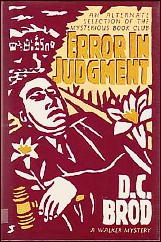
(Compare the price of this book, $4.50, with the one by Stefanie Matteson that I reviewed just prior to this one, $3.95, from the same publisher. Compare it with the price of paperbacks at the time you’re reading this, several months from now.)
But as for the question, “Is this book worth $4.50?,” I’d hesitate a little, but I’m going to say yes. I enjoyed it (and enjoyed it more than I thought I was going to, after the first couple of chapters). It’s a good-sized book, 258 pages of smallish print, and if you enjoy PI stories, I think you’ll be getting your money’s worth.
On the other hand, a general rule of thumb is that you may want to be careful of PI books written by authors with initials for a first name. The “D” stands for Deborah, and by and large, women still don’t write hardboiled PI novels. (But neither did Rex Stout. All I’m saying is be wary.)
Brod’s detective hero is Quint McCauley, a struggling PI new to the small town of Foxport, somewhere outside of Chicago. He’s already made the mistake of crossing one of the town’s leading legal lights, and jobs are getting hard to come by.
One that he has in this case, accepted on a contingency basis, is that of trying to determine whether or not a judge’s death was really a suicide. A clause in an insurance policy means a difference of a million dollars, payable to the widow.
The judge, by the way, was under indictment in an bribery case, but Quint still wonders why the case was closed so quickly by the police department. (He is also on the outs with the chief of police, you might be interested in knowing, ever since he tried to pick up the man’s wife in a bar some time earlier.)
Quint does have the advantage over the police, as far as the case is concerned, in that he was the one who found the body. He was also the one who found (and went off with) the pictures he found stashed away in a filing cabinet. He shouldn’t have, and that’s where the title comes from.
It’s a complex case, in other words. The difficulty I found with it, in the early going, is that the writing is talky and flat, and McCauley, who tells the story, sounds whiney and apologetic, almost to the point of exasperation.
Points of the story where he should be angry, he says he’s angry, but he doesn’t seem angry and he doesn’t act angry. (Maybe he’s more cold-blooded than I thought he was.)
If you decide to read it, though, bear with it, and you’ll eventually find the plot has enough twists, major and minor, to make it worth the effort. This is a mixed review, in other words, but in balance, it should read more positive than negative.
Rating: B Minus.
— This review was intended to appear in
Mystery*File 35. It was first published in
Deadly Pleasures, Vol. 1, No. 3, Fall 1993 (slightly revised).
The Quint McCauley series —
1. Murder in Store. Walker, 1989.
2. Error in Judgment. Walker, 1990.
3. Masquerade in Blue. Walker, 1991. Reprinted as Framed in Blue, Diamond, 1993.
4. Brothers in Blood. Walker, 1993.
5. Paid in Full. Five Star, 2000.
[UPDATE] 09-25-11. Here it is, some twenty years later, not just a few months, and while prices of mass market paperbacks seem to have stabilized in the past year or so, it’s at a level that’s essentially double it was in 1991.
The bigger problem, as far as I see it, is the total lack of diversity that exists in the way of detective fiction published today in MMP. Many publishers no longer have lines of genre fiction, and of those that do, almost all of it is of the “cozy” variety, with protagonists more interested in their hobbies (quilting, teddy bears) or small shops (antiques, herbs) than they are in solving murder cases, mostly incidental.
In my opinion, ebooks will soon force MMP publishing into oblivion, a sad day as far as I’m concerned, but as other people have also pointed out, I’ll still have plenty to read.
Sun 25 Sep 2011
MAX BRAND – The Outlaw Redeemer. Leisure, paperback, March 2004. Hardcover edition: Five Star, 2000.
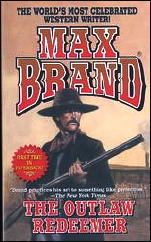
One way or another, most traditional westerns have elements of crime fiction built into their plot structure, and naturally I wouldn’t have brought it up if both of the short novels contained in the case at hand, The Outlaw Redeemer, weren’t such prime examples, but in markedly different ways.
In “The Last Irving,†which takes place in the more recent Old West (Irvington is wired for electricity, for example, and the characters drive proudly around in flivvers) the heir to the no longer existent Irving fortune, a city yokel by the name of Archibald, returns from the East to revenge himself on the two crooks who conned his Uncle Ned out of his total financial worth.
This is the standard tall tale of a (perceived) dumb sap who (it is anticipated) comes out on top by the simple expedient of setting his two opponents one against the other.
While there is more anticipation than there is follow-through, I can’t imagine anyone not finding the ending at least mildly satisfying. The title story which follows, however, “The Outlaw Redeemer,†comes with some real surprises, most of them quite unexpectedly so, and this is the one that’s by far the more enjoyable of the two.
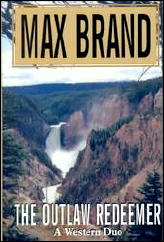
The opening is nothing less than Biblical in nature, with lots of “begatâ€s that trace the lineage of the tale’s two primary antagonists: (a) the pure in heart John Tipton, who becomes a Texas Ranger and whose constant quarry is (b) the brutish and devilish criminally-minded Hubert Dunleven, nicknamed either Shorty or Bunch, “both of which were derived from his physical peculiarities.â€
Their efforts as directed against each other are the stuff from which legends are made. Can a western ever be called utterly charming? Dunleven is that rarest of beings, an outlaw with a silver tongue. Take for example, this speech he makes to the beautiful Nell — and, oh, yes, there is indeed a girl, and of course she comes between them.
Consider the eloquence to be found on page 118, after Dunleven has requested that Nell make breakfast for him, a request she cannot refuse:
“For instance,†he [Dunleven] explained, “there are your hands. Hands have an eloquence all their own. Your small brown ones, for example, have never before served a meal to a hungry man without enjoying their work. They have been gay and swift and tireless. They have carried dishes to every hungry table with a certain charming eagerness. And it has been a sad thing to sit here and to watch those hands working like slaves, heavily, joylessly, dragging themselves along.â€
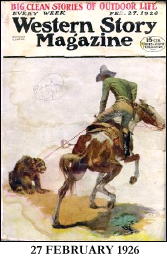
Nell is not, however, emphasis not, your usual western heroine. As are the two male protagonists of the tale, she also is flawed, and I confess – I admit it – I did not know, with several chapters remaining to go, which way the story was going to come out.
That is it a happy ending, you may rest assured. You may also be assured that you will not know in which way it will end happily, but it will.
PostScript: Both of the these stories first appeared in the pulp magazine, Western Story Magazine. “The Last Irving†appeared as “Not the Fastest Horse,†as by John Frederick in the November 7, 1925, issue; and “The Outlaw Redeemer†appeared as “The Man He Couldn’t Get,†as by George Owen Baxter in the February 27, 1926, issue.
In a subtly strange but substantial way, I like the original titles better.
— Reprinted from Durn Tootin’ #5,
July 2004 (slightly revised).
[UPDATE] 09-25-11. Your mileage may vary, but although it doesn’t compare to the covers of the western paperbacks of the 1940s and 50s, I much like the cover of the Leisure book over that of the totally generic photo on the hardcover edition.
And speaking of Leisure books, most mystery-oriented blogs have concerned themselves with the loss of the Hard Case Crime paperbacks when Dorchester went under, and rightly so. But I also miss the box of four western paperbacks that came by mail from them every month, with at least two of them almost always reprints from the pulps.
Sat 24 Sep 2011
LA BANDERA. Société Nouvelle de Cinématographie (SNC), France, 1935. Released in the US (1939) as Escape from Yesterday. Annabella, Jean Gabin, Robert Le Vigan, Raymond Aimos, Pierre Renoir, Gaston Modot, Margo Lion. Based on a novel by Pierre Dumarchais under the name of Pierre MacOrlan. Director: Julien Duvivier.
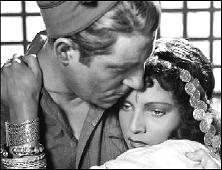
There was a day last month that TCM showed Jean Gabin movies for 24 hours straight, and I taped about 16 hours’ worth. As I make my way through watching them, my comments will show up here. This is the first.
I’ve not seen enough French films of this era for me to say anything clever or even intelligent about them in that regard. I’ll have to also refrain from saying anything about other films that Jean Gabin made, unfortunately, except to say that this one was early in his career, with both La grande illusion and Pépé le Moko not coming along until 1937, the two films that really cranked his career into high gear.
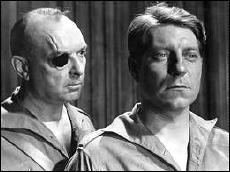
He’s a man on the run in this one, having killed a man in France and finding himself broke in Spain in the very next scene. The Spanish Foreign Legion is his only option. He signs up, trying (as many men did) to forget his past and not to think (too much) about his future.
He makes some friends, a couple of enemies, including one (he believes) is on his trail for the murder he committed. He also meets a Moroccan girl (Annabella), a dancer in what can only be called a dive, for where else is there for a legionnaire to go, away from the barracks and the day to day drudgery of a soldier’s life?

The first half is slow going, with the quick transitions between scenes making it a bit of a challenge to follow the story, but once Gabin finds himself in one spot, somewhere in the African desert with all-but-invisible Arab enemies, the story settles down as well. To a tale of honor, of course, and manhood, and life in general as well as in particular.
I will not tell you if the movie ends tragically or not, but either way, it is one of those films that could easily do so. But there are other reasons to watch this movie, other than the story. The film-making techniques, and what the director added to this film visually, for example, catch the eye and intrigue the mind more often as not, making this movie one I will probably watch again, perhaps even soon, for that very reason.
YouTube clips:
(1) A man is killed.
(2) Gabin and Annabella meet for the first time.
(3) The finale.
Sat 24 Sep 2011
Posted by Steve under
ReviewsNo Comments
AMANDA CROSS – The Question of Max. Alfred A. Knopf, hardcover, 1976. Paperback reprints include: Avon, 1977; Ballantine, May 1984.
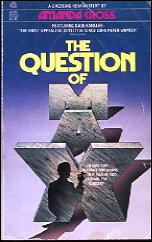
My first experience with a Kate Fansler novel, of which there were 14, with The Question of Max being the fifth. My first reaction (favorable) is that if you like very literary and very quotable (and early feminist) detective fiction, in terms of both the writing and the subject matter, you will like Amanda Cross, or at the least you will like this book.
If, however, your greater pleasure is in terms of solid plotting and following the detective on the case, watching and identifying with her (him) as she goes, why then, we’re on slipperier ground. I was going to explain my unhappiness in greater detail, but after going into the same at great length, I’ve scrapped everything I intended to say and have decided to give you an abbreviated (and less invasive) version instead.
When Max Reston, a literary figure of some small renown, comes calling on Kate at her country refuge in the Berkshires, it is to invite her to drive him to the estate of Cecily Hutchins up in Maine. Max is Cecily’s literary executor, and prowlers have been seen in the vicinity of the manor house where she lived alone after her husband’s death.
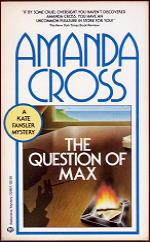
Does Max have an ulterior motive? Kate isn’t sure, but she decides to take the request at face value, and takes Max to Maine, where among other things, they find the body of a dead girl in the rocks along the shore not far from Cecily’s home. More amazingly, Kate recognizes the girl as one of her grad students.
Which is where the problem in the plotting first arises. Kate, a university professor of literature, makes a mistake on page 47 that sends her on a false trail for the next 150 pages, a mistake that I don’t think she should have made. I was in academia myself for a good many years, and speaking for myself, I just don’t see it.
It’s a leisurely told tale, and for much of the book it is not even known whether or not a murder has occurred. You may assume there was, as I did, but when it comes down to it, I still rather resent being sent down a path (or a hairpin turn of the plot, metaphorically speaking) as creaky and shaky as this one is.
Thu 22 Sep 2011
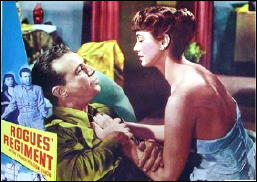
ROGUES’ REGIMENT. Universal International, 1948. Dick Powell, Märta Torén, Vincent Price, Stephen McNally, Edgar Barrier, Henry Rowland, Carol Thurston, James Millican, Richard Loo, Philip Ahn. Director: Robert Florey.
Search and Destroy, the most recent movie I happen to have reviewed on this blog, appeared some four years after the end of the Viet Nam war. Most of Rogues’ Regiment, on the other hand, takes place in Viet Nam (aka French Indo-China) at the beginning of the conflict, as it originally took place.
The premise is that one of the would-be defendants at the Nuremburg Trials, one Martin Bruener, had made his escape from Germany and was never found. As his photograph had never been taken, except for one in which only the back of his head can be seen, no one even knows what he looks like.
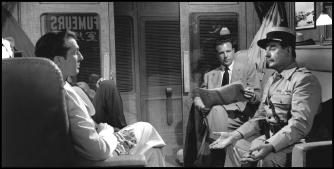
The trail, though meager and cold, leads one man, Whit Corbett (Dick Powell), to Indo-China, where the French and the Foreign Legion are desperately fighting to keep control there. So desperate are they that they are accepting former WW2 soldiers from all over the world — including Germany — as new recruits. Hence the title of the film, Rogues’ Regiment.
Powell goes so far as to sign up for a tour of duty with the Legion, and although we do not know this right away, so does his quarry (Stephen McNally). Aiding the latter is Vincent Price, a German posing as a Dutch importer of antiques (and guns for the Vietnamese revolutionaries).
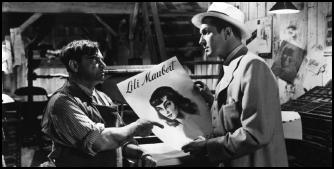
Aiding Powell, though, is a French operative (Märta Torén) posing as a nightclub singer, and the latter are more than a match for the former. Quite predictably Powell falls for Miss Torén, who also gets to sing a song or two. Powell does not.
The movie is enjoyable enough – there is no major skimping on the cast or the production values – but the biggest problem I had with the film is that it makes everything involved with catching ex-Nazis all too easy. Nearly a one-man job, in fact, if the one man happened to be Dick Powell.
Thu 22 Sep 2011
STEFANIE MATTESON – Murder at Teatime. Diamond, paperback original, March 1991.
This second installment of the adventures of noted actress and movie star Charlotte Graham takes place in Maine, where a world-famous professor and expert on herbal remedies is poisoned by one of the products found growing in his own garden.
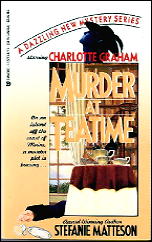
The motive may have been his stout opposition to the proposed economic development of the island where he’s living (golf course, hotel and condos), or it may have been connected to his valuable collection of herbal incunabula (books printed before 1500), discovered soon after his death to be missing.
Charlotte Graham is deliberately modeled on the old-fashioned Katharine Hepburn type of movie star, independent, only occasionally regretting that she has put her career over love and marriage. She is, however, in love with the world and nearly everything in it.
Although at first Charlotte finds herself nervous in a place that “didn’t have sidewalks,” she is soon won over by the raw beauty of Maine and its inhabitants. And where else in the country would she be asked by the harried chief of police to aid him in his investigation, simply because of her past exploits in the field?
It has to be a chore for a mystery writer, book after book, to get his/her amateur detective involved in what should really only be police investigations. In a way it’s refreshing to see Matteson make no bones about it, and get Charlotte Graham right to work!
This is but one example of how this case maintains itself as a direct descendant of the mysteries of the Golden Age of Detection. As another, there are only a few major suspects on the relatively isolated island. Their alibis have to be checked out individually, their motives examined in both direct and casual conversation, and in the end they are all gathered together in a final confrontation, during which the murderer bolts and pursuit must follow.
A love of books and the lore of book collecting are also important ingredients of this novel, along with the herbs and the pitfalls of life in academia. If I thought Mattes0n’s first book, Murder at the Spa slowed down too often to nearly a halt by the intrusion of as much about the spa business as I wanted to know, she certainly makes up for it with this one, which has almost everything I’m looking for in a detective novel.
Almost, but not quite. I did have a little bit of trouble with the ending, and with a
[
WARNING: Major Plot Alert!]
I’m going to tell you about it here. [Don’t read farther without having read the book first, if you’re going to.]
The problem, as I see it, is that the evidence that eventually traps the killer is found carelessly left lying in a book as a bookmark. I don’t know about you, but if I’d ever murdered anybody, I’d be a little bit more careful about incriminating myself than this.
(Of course, I’d be the kind of killer who keeps returning to the scene of the crime over and over again, looking and looking for anything at all that I’d missed!)
Rating: B.
— This review was intended to appear in
Mystery*File 35. It was first published in
Deadly Pleasures, Vol. 1, No. 3, Fall 1993 (slightly revised).
The Charlotte Graham series —
1. Murder at the Spa (1990)
2. Murder at Teatime (1991)
3. Murder on the Cliff (1991)
4. Murder on the Silk Road (1992)
5. Murder at the Falls (1993)
6. Murder on High (1994)
7. Murder Among the Angels (1996)
8. Murder Under the Palms (1997)
Wed 21 Sep 2011
REVIEWED BY DAN STUMPF:
THE WESTLAND CASE. Universal, 1937. Preston Foster (Bill Crane), Frank Jenks (Doc Williams), Carol Hughes, Barbara Pepper, Astrid Allwyn, Clarence Wilson, Theodore von Eltz. Based on the novel Headed For A Hearse, by Jonathan Latimer. Director: Christy Cabanne.
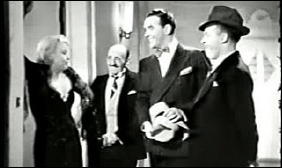
The Westland Case is part of Universal’s short-lived “Crime Club” series — which would be usurped in the 40’s by the dreary Inner Sanctums, but that’s another story.
It’s a jaunty little effort, fast-paced and well-played. Preston Foster and Frank Jenks put just the right soupcon of boorishness into their portrayals of a pair of hard-drinking PI’s, Bill Crane and Doc Williams, coming off flip and obnoxious without being crude – no small trick, that.
They are ably supported by a hand-picked cast of no-names, including third-billed Barbara Pepper, who has about ten minutes of screen time, no relation whatever to the Plot [a locked-room affair] and delivers a devastating Mae West impression.
She is matched perfectly by Clarence Wilson, a diminutive, squeaky-voiced Adolphe-Menjou-wannabe who seems to know he’s got the best role of his career here and positively shines as a stuffy, lecherous lawyer.
Editorial Comment: Follow this link for a list of the other films in the Crime Club series, and Walter Albert’s review of one of them, posted on this blog about a year ago.
Wed 21 Sep 2011
REVIEWED BY WALTER ALBERT:
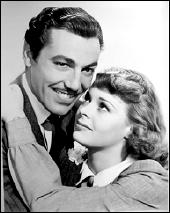
TALL, DARK AND HANDSOME. 20th Century Fox, 1941. Cesar Romero, Virginia Gilmore, Charlotte Greenwood, Milton Berle, Sheldon Leonard, Stanley Clements, Marc Lawrence, Addison Richards, Vicki Lester, Nestor Paiva, Marion Martin. Dances staged by Nick Castle; music and lyrics by Leo Robin and Ralph Rainger. Director: H. Bruce Humberstone. Shown at Cinevent 40, Columbus OH, May 2008.
I’ve included one acting credit more for its incidental interest than as a record of a significant performance in the film. Vicki Lester was, of course, the name of the lead female character in A Star Is Born (played by Janet Gaynor in 1937, and by Judy Garland in 1954). The actress Vicki/Vickie Lester (her real name was “Vickie,” with “Vicki” adopted for the screen) appears to have played her first role (unbilled) in The Vogues of 1938, with her last credit given for 1943.
Also, my wife reminds me that we saw Cesar Romero in the lobby of the Roosevelt Hotel in Hollywood in 1991. I recall that he had a glamourous lady on either arm, and was flashing his patented smile. It was not uncommon to spot stars at the Roosevelt, usually there as guests for the Saturday night banquet.
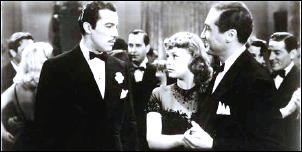
Anyhow, Romero was in his prime when this film was released in 1941, giving a stellar performance as a Chicago gangster, known for his ruthlessness in handling threats to his power. His bumbling sidekick is played by Milton Berle, his equally ruthless rival by Sheldon Leonard, his female associate by Charlotte Greenwood, and the pretty young thing who causes his best-laid plans to go awry, by Virginia Gilmore.
This is a comedy, with some music (Greenwood has one number in which she recalls some of the glories of her high-kicking days on the dance floor), and highly entertaining. It was remade in 1950 as Love That Brute, with Romero in Leonard’s role, and Paul Douglas as the lead.
Editorial Comment: There’s a long series of clips from this film (23 minutes) here on YouTube.
Tue 20 Sep 2011
Posted by Steve under
Reviews[7] Comments
REVIEWED BY BARRY GARDNER:
JACK O’CONNELL – Wireless. Quinsigamond #2. Mysterious Press, hardcover, November 1993; paperback, 1995.
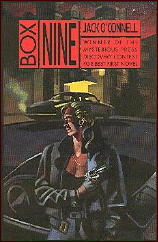
One thing you got to give this O’Connell dude, he don’t do the same old stuff. Box 9 was one of the strangest books I’d read in a while, and Wireless may be even stranger. It’s set in the same decaying New England town, Quinsigamond, and the presence of Lenore Thomas, the freak lady cop of the first volume haunts the second though she is not physically present.
The plot? Yes, well the plot … there are these anarchist-type radio jammers, you see, and several ethnic criminal gangs, and then there’s this lady cop who’s sort of the spiritual heir of the heroine (?) of his first book, and there’s a couple of dwarfs, a radio show hostess with a late night sex show, and a renegade FBI agent who likes to set people’s heads on fire … no, hell, no, I’m not making it up, that’s who it’s about, and it’s not funny at all, blackly or otherwise.
The activities of the jammers provide the focal point. but it’s about a lot more than that. All of these weird and diverse people come together and move apart, and things change, and there are several resolutions of a sort. It’s no doubt a metaphor for several weighty philosophical concepts, but I’ll let you draw your own conclusions as to which and how valid.

It’s a difficult book to describe coherently, and impossible to categorize. I suspect, though, that semi-smug, middle-class whitebreads like myself are not really its intended audience. It’s well and powerfully written in the present tense, with shifting viewpoints that show each of the major players with sometimes startling clarity; though to say that it illuminates them might be misleading. It’s more akin to flashes of lightning on a stormy night, when a murky landscape is shown in bright relief for a brief instant, and then shadow reclaims the world.
It’s about alienation and family and love and hate and power, and it’s worth you time to read it, I think. You may not be able to believe in the flickering, off-center world it presents, and then again you may; but in either case it’s likely to drag you along for the ride, shaking your head and wondering where in the hell it’s all going to end. Be warned, though, it’s rougher than a split-oak log.
— Reprinted from Ah, Sweet Mysteries #8, July 1993.
Bibliographic Notes: There were two more novels in this series, The Skin Palace (1996) and Word Made Flesh (1998).
Continuing to Google for information about either the author or his work, the series seems to have gotten more attention from Science Fiction fans than mystery readers. A long interview with the author, Jack O’Connell, can be found online here.
Mon 19 Sep 2011
FRINGE, THE TV SERIES: A PRIMER
by Michael Shonk

FRINGE. Fox-TV. Bad Robot Production / Warner Brothers. September 9, 2008 through present. Created by J. J. Abrams, Alex Kurtzman and Robert Orci. CAST: Anna Torv as Agent Olivia Dunham, John Noble as Dr. Walter Bishop, and Joshua Jackson as Peter Bishop.
“Neither Here Nor There.” (Fourth Season premiere. September 23, 2011. Friday at 9E/8C.) The teams on the two worlds work together to solve the case of a shapeshifter, and Agent Lincoln Lee (Seth Gabel) joins his world’s team when no one remembers the existence of Peter Bishop. (Summary from TV.com.)
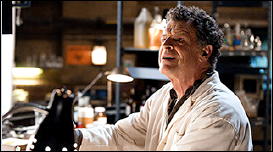
Fringe is a science fiction police procedural series too often ignored by mystery fans. While it is an arc series with occasional stand-alone episodes, the fourth season turns the arc into a circle and offers new viewers the best chance to jump in as everything changes.
The series is focused on three characters, FBI agent Olivia Dunham, Mad Scientist Walter Bishop, and Walter’s genius son Peter. Fringe is a special unit of the FBI that examines mysteries involving strange science.
This means dealing with strange crimes that would test Banacek, such as everyone on board an airborne passenger plane dissolving. While dealing with the strange and gross, Fringe discovered the parallel universe and that the other side was here and for an unknown reason causing trouble.
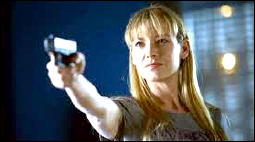
Only Walter had already been to the other universe and has a secret: both Peters were dying. Our universe Peter died, but the other Peter remained alive but with little time left. The other universe Walter (Walternate) discovered a cure but was unaware of it because of the actions of a baldheaded man called an Observer.
Little is known about the Observers except they show up at every important moment of time and have a way of being in Fringe episodes like Hitchcock did in his movies. Walter had been watching, entered the parallel universe, took dying Peter to our universe, saved young boy’s life and kept him.
Well, now Walter had really done it. Both universes began to bump into each other causing death and destruction, with the other side getting the worse of it. The other universe then sent shapeshifters over here to find the mysterious device that would save their universe. Meanwhile, our Fringe division solved the weekly mystery, tracked down the bad guys, and fought off the invasion from the other universe.
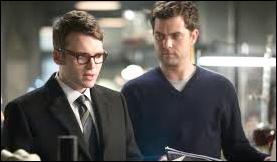
The third season alternated episodes between the two universes where we met our characters alternate universe counterpart (except for now grown up Peter who was from there). We learned the other universe was not evil and only a few had goatees. They, like us, just want to survive.
Things remained strange but our Fringe finally found the final piece of the device to save the universe by taking out the other. The machine would only work with Peter in it, forcing him to chose between the universes.
He then was sent into the future and learned the only way one universe would survive was if both survived, So Peter connected the two universes. Our Fringe and theirs must now work together to save both universes. Peter disappeared and no one noticed. Cut to a group of Observers where we learned Peter was not just gone, he had never existed.
So, got that? Well, don’t worry about it. If Peter never existed, he never died in our universe, he and Olivia never fell in love, he and Fauxlivia (other universe’s Olivia) never had a baby, and Walter never stole Peter from the other universe and the reason for the universes problems change.
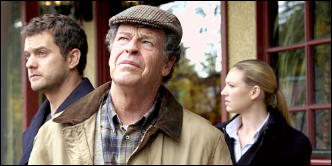
All the characters who had evolved due to Peter’s influence will change to who they would have become if they had never met Peter. Shades of It’s a Wonderful Life without Clarence! This means the writers have a whole lot of explaining to do, and that means you newbies can learn what is going on along with us longtime viewers
If all this is sounding a little Lost to you, there is one major difference. Lost made it up as they went along; Fringe, from the beginning, has had an ending all ready planned. The clues, the strange twists, the answers all will be revealed and make sense (we hope) when the series stops.
If you enjoy mixed genre television, with some science fiction and horror tossed in with your FBI police procedural story, give the series a try. Besides Fringe offers viewers twice the universes of forensics than CBS’s CSI:NY.
« Previous Page — Next Page »

